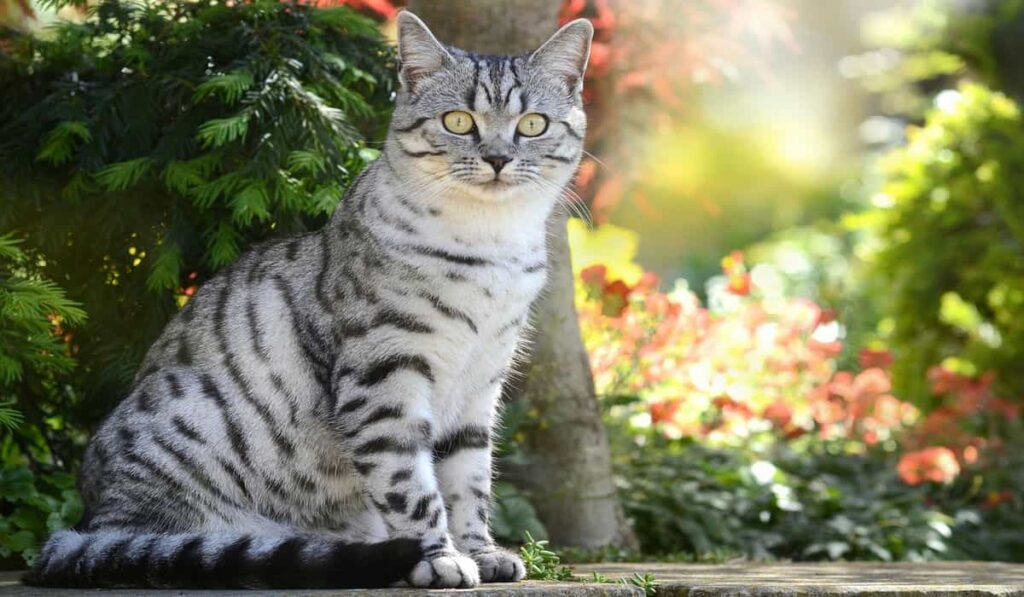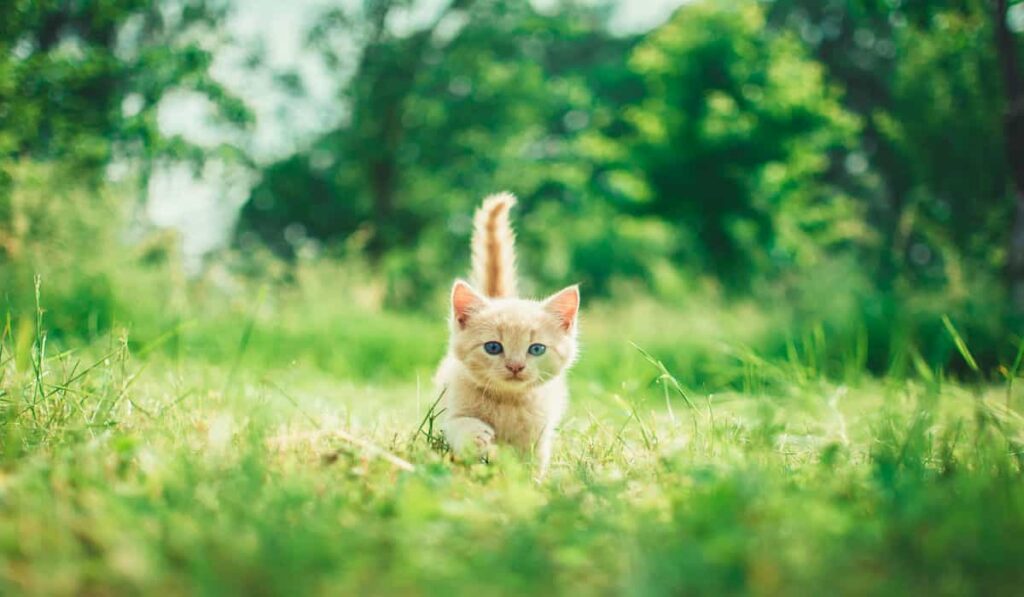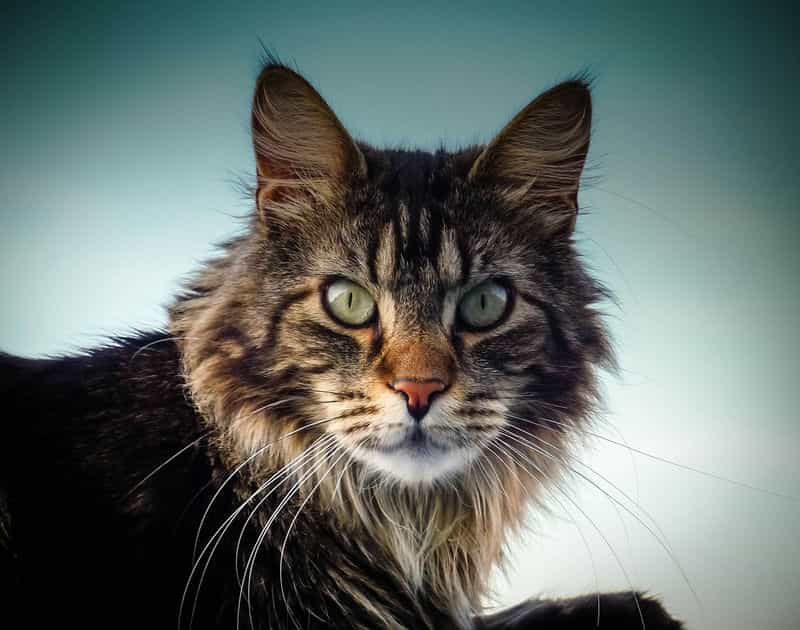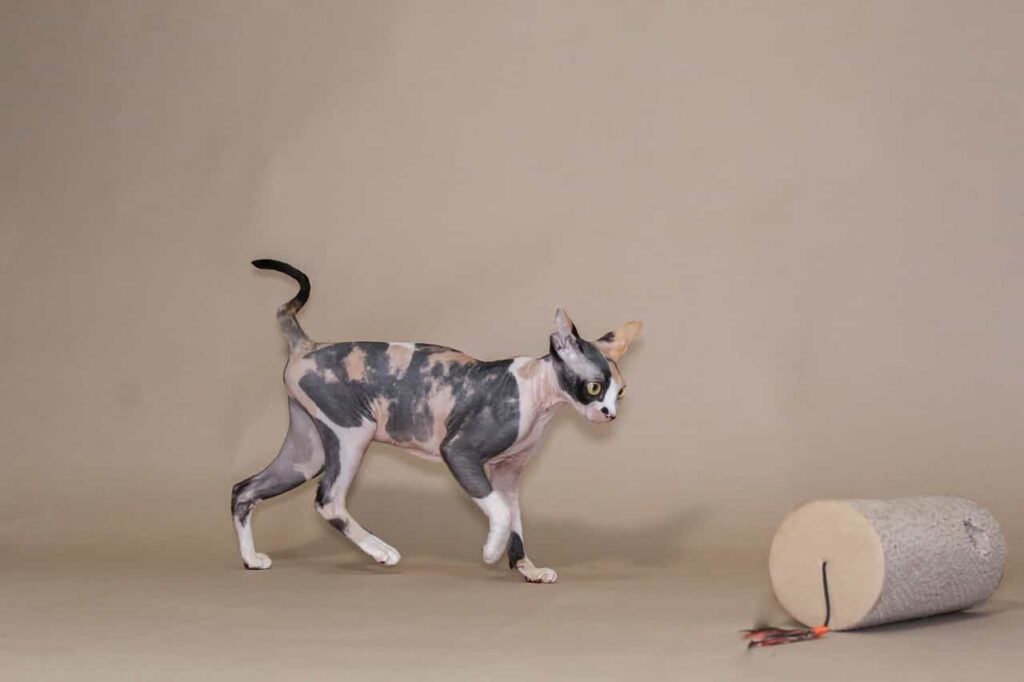Welcome to the enchanting world of the Cornish Rex cat, a breed as unique in personality as it is in appearance. With their striking curly coats and slender figures, Cornish Rex cats are not just a delight to behold but also a joy to live with. Known for their playful and affectionate demeanor, these cats are more than just pets; they are companions with a charisma that captivates the hearts of all who meet them.
This guide will take you through the intricacies of caring for a Cornish Rex, from understanding their distinctive physical characteristics to mastering the art of grooming and socialization. Whether you’re a seasoned Cornish Rex enthusiast or considering welcoming one into your home, this comprehensive overview will provide you with the insights needed to ensure a happy and healthy life for these remarkable felines.
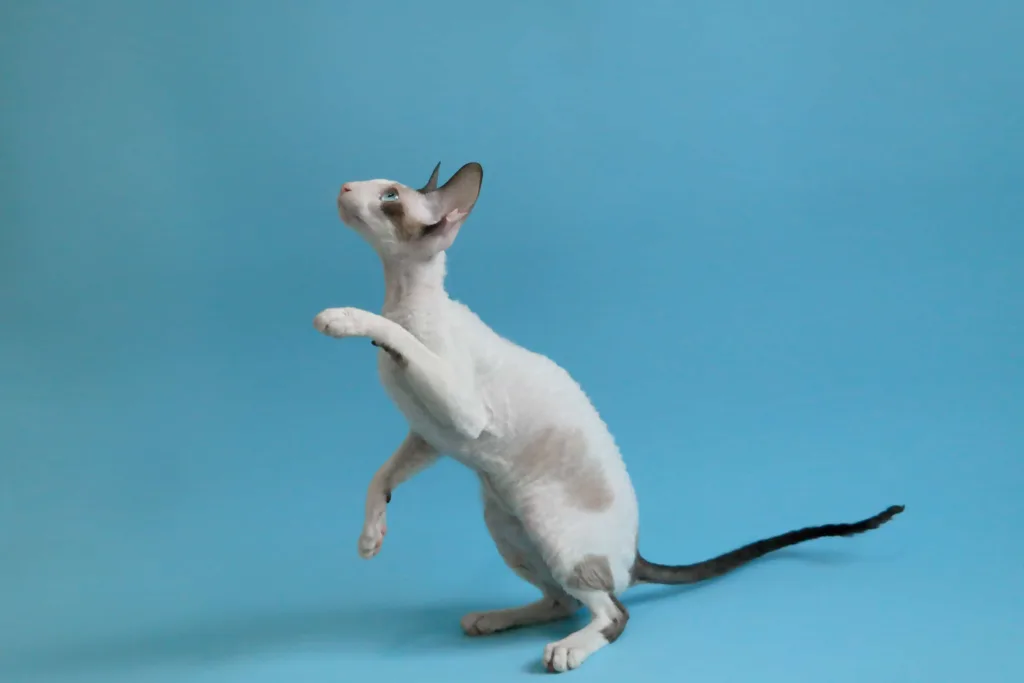

Table of contents
Cornish Rex Cat Breed
The Cornish Rex cat is an unusual breed- known for its curly coat, dog-like look, and birthplace Cornwall, United Kingdom. Cornwall is a magical sword from the magical corner of Great Britain.
It’s the birthplace of King Arther (late 5th and early 6th century). The Cornish Rex is a very interesting cat breed. It resembles the Devon Rex breed, but the two breeds are separate.
You’ll know everything about the breed after reading the whole article. The breed is named according to its birthplace and Rex Rabbit, as they can run fast.
Breed Specialty of Cornish Rex
Other names:
Marcel cats
Personality:
Very active and playful, high jumpers and runners like the dogs, intelligent, attentive seekers, and very affectionate to their owners. They’re not much friendly with children and strangers.
Coat pattern and colors:
Curly coats are their trademark, and they have only undercoats, not 3 layers of the coat. They’re prone to hair loss; sometimes they get bald, or a large portion of the coat gets hairless. Coat patterns are Tabby, spotted, colorpoint, and bicolor, and They come in any color.
Coat length:
Short
Weight:
6-10 Pounds
Length:
Up to 18 inches
Eye color:
Gold, Green, Blue, Amber, Orange, Yellow
Life span-
Up to 20 years if good care is taken.
Hypoallergenic: Yes, sometimes.
Origin: United Kingdom
Origin of the breed-Cornish Rex
You already know that Cornish Rex is an unusual breed. 1950, a cream-colored male kitten was born on a farm in Cornwall, United Kingdom. His name was Kalibunker. He was the first Cornish Rex cat.
His coat was extremely unusual- meaning he owned a curly coat, which was a genetic mutation. The farm owner backcrossed Kalibunker with her mother, and 2 more curly-coated kittens were born- one is male- Poldhu another is female- Lamorna Cove.
Lamorna was brought to the USA and crossbred to a Siamese cat to give the breed a different look- long whippy tail and big ears. The Devon Rex looks like Cornish Rex, but they’ve guard hairs and shed- which Cornish Rex doesn’t have.
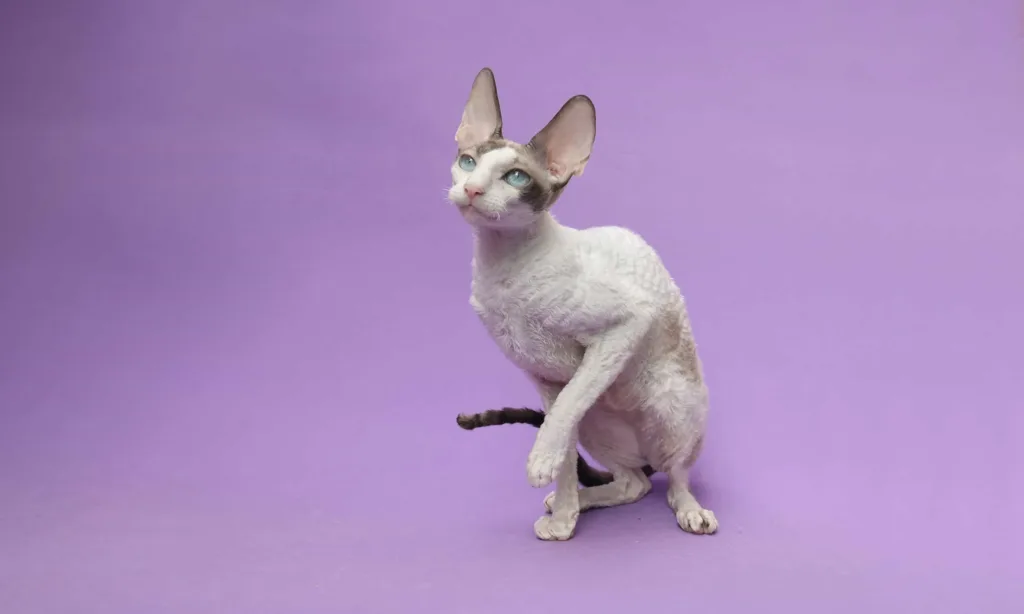

The inter-bred between Devon and Cornish was attempted, but the kitten didn’t have short and wavy fur. So, crossbred between the 2 breeds isn’t permitted.
Moving forward, Cat Fancier’s Association recognized Cornish Rex as a breed in 1964.
The appearance of the breed-Cornish Rex
Body:
They look like Grey Hound dogs because their back is slightly arched, their waist is narrow, and their limbs are long. The whole body is muscular because they run and jump a lot. A hair locket is visible in the neck area.
Head:
The head is small, and the face is egg-shaped. Small mouth with a whisker pad, and the nose is medium size.
Ears:
The big, pointed, alert ears say their ancestors were Siamese cats. The ears are situated high on the head and almost near the eyes.
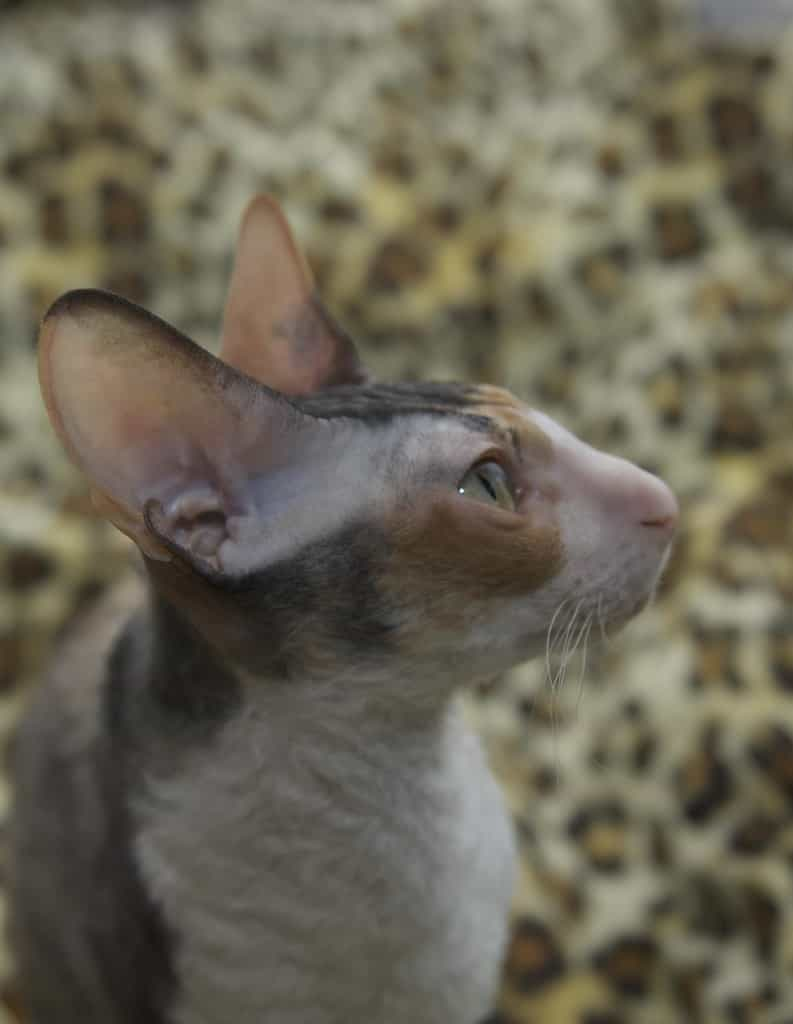

Eyes:
The eyes are big, floating, alert, timid, and Almond-shaped.
Legs and paws:
The legs are very high, heavy, and well-muscled. The paws are oval,, with five fingers in the front and four at the back. The Corish stands well because of its legs and paws.
Tail:
The tail is medium long and thin.
A curly coat gives them a very different look.
Temperament and nature of Cornish Rex
Cornish Rex is active, playful, outgoing, talkative, and social and loves to lap on cold winter days. A very good family cat loves to stay with family and go outside. They’re very adventurous, like the dogs, and run very fast. They’re also very much talkative.
They try to seek your attention with their meowing. They love children and strangers, and also other pets. A very intelligent, easy-going, and alert breed.
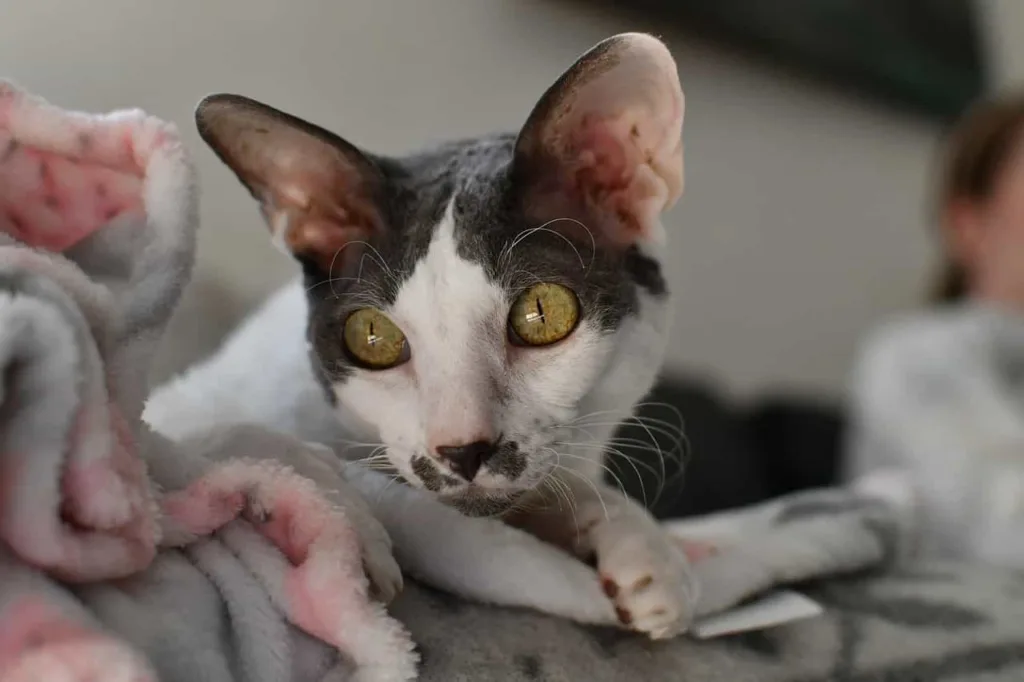

You can’t keep any cupboard and shelf safe from a persistent Cornish because they run and jump like a sprinter. They steal food behind you when you’re preparing Dinner.
Cornish Rex kittens
The breed is very agile and energetic. So the kittens of Cornish Rex are one step ahead. The kittens love any kind of physical activity, intelligent and quick learners. They can adjust and get used to their surroundings and situations very easily.
The kittens are very social and friendly and are often found snooping around the house. In adulthood, they behave like Greyhounds. So, the signs are seen from kittenhood.
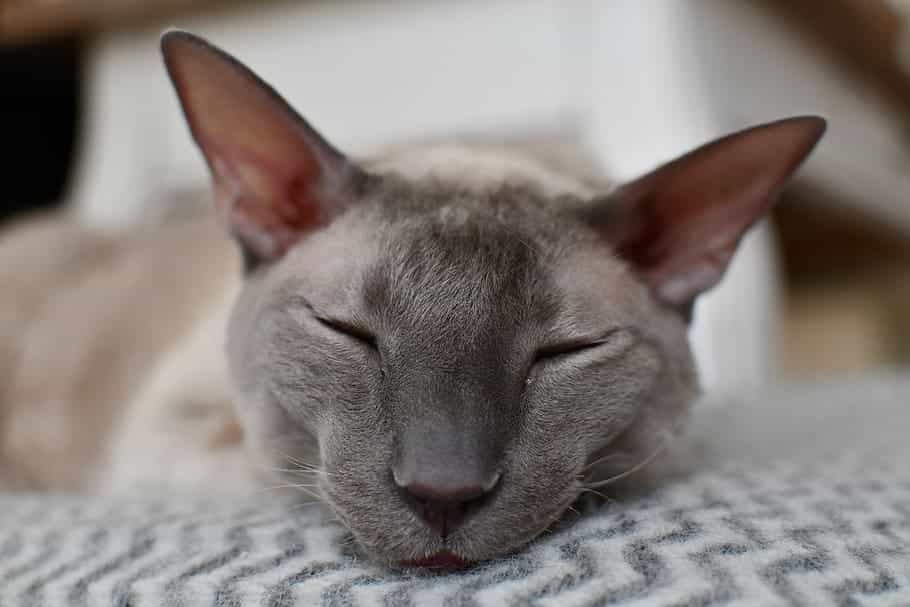

You should encourage them to train by awarding them tasty snacks. Tuna or Kycklingfile will work wonders in the training of your kitty. Provide your kitty with a healthy and balanced diet. Kattunge is the best food for kittens till 1 year of age.
Cornish Rex Cat Caring Tips
Cornish Rex is almost a high-maintenance cat because you have to bathe them once a week and keep their ears clean regularly. Besides, they can’t absorb oil like other cats’ coats. So, you have to bathe them at least once a week. Let them use baths from the kitten age.
Thus, you won’t have to face any difficulties bathing them. Besides, Their ears are very big. So, the ears must be cleaned regularly.
Finally, cornish need to follow a regular dental care routine such as brushing weekly and professional checking and cleaning. Their nails should be cleaned after every 15 days gap.
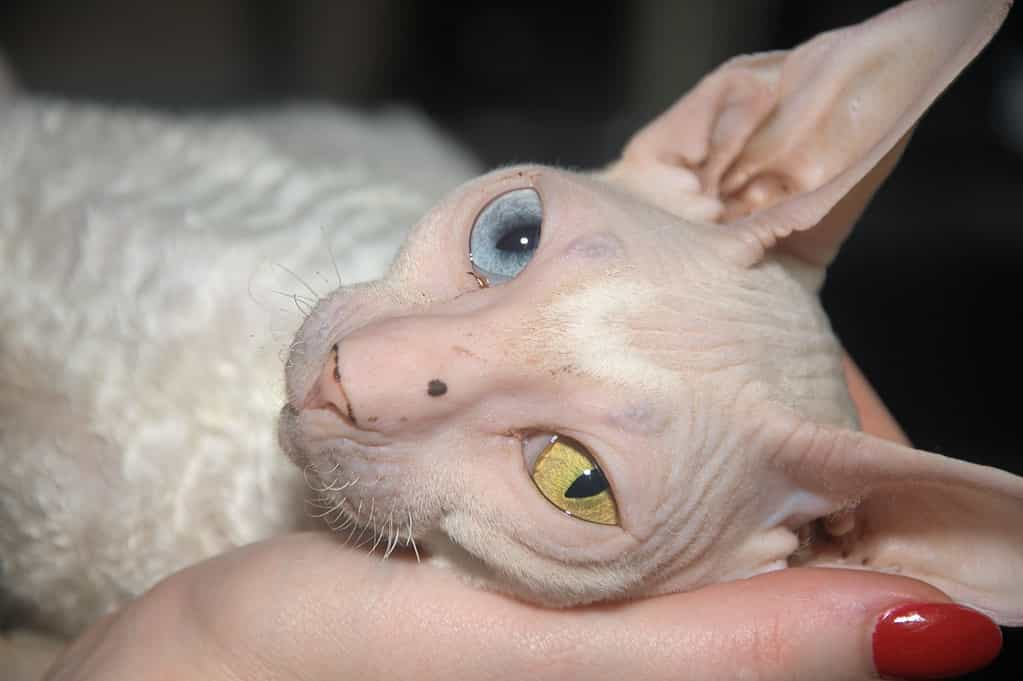

Let them out daily for running, jumping, and adventuring, as their habit is like Grey Hounds. Provide them with enough toys, long cat trees, faux mice, feather toys, and treat puzzles. They love interactive playing sessions with children and other pets also. So, spare time to play with them.
They also like to learn tricks and follow your commands- like come, go, sit, and pick up things with their paws.
Health and problems of the breed Cornish Rex
Some health problems can disturb the athletic life of your Cornish Rex. Such as-
Arterial Thromboembolism:
It is called arterial thromboembolism when blood clots grow in the arteries and make obstacles in pumping and circulating blood through the whole body.
Patellar Luxation:
This is a very common problem. When the knee cap has been displaced- which means out of place- it is called out of place. When cats reach middle age, most of the cats face the problem.
Hypotrichosis:
It is a genetic disease- found in several cat breeds. Cornish Rex is one of them. It causes thinning and balding, which develop patterns and patches on the torso and head. A kitten can be born with this problem, or the problem can be visible shortly after birth.
It is not painful but causes Sunburn and dryness of the skin. There is no cure for Hypotrichosis because it’s a genetic problem. If your Cornish Rex faces the problem, please don’t breed it.
Blood type:
When your pet gets injured or needs a blood transfusion,, it’ll be difficult to survive if it inherits a rare blood type. So, conduct a blood test before adopting a pet to know whether your pet has a rare blood type or not.
Kidney disease: the most common problem among the Cornish Rex breed. When they face difficulties urinating and pass discolor Urine, you must understand that your cat has problems with and kidney, and it is time to take it to the veterinarian.
Arthritis: 70% of Cornish Rex cats get attacked by Arthritis at 10 years of age. Cats are very good at hiding their pain. So, keep a to your cat’s health. Don’t ignore them because of your busy life.
Food and nutrition that Cornish Rex needs
There is no specific food and nutrition demand that Cornish Rex needs. Remember that your pet is an active jumper, runner, and sprinter. So, ensure enough protein and nutrition for them. Don’t feed them a full bowl at a time; just a few nibbles are enough.
Active cat breeds need a calorie intake, but Cornish Rex often surpasses the limits of their needs. Don’t fill the bowl every time, even if your leak; it is clean. Feed them according to their age, weight, and activity.
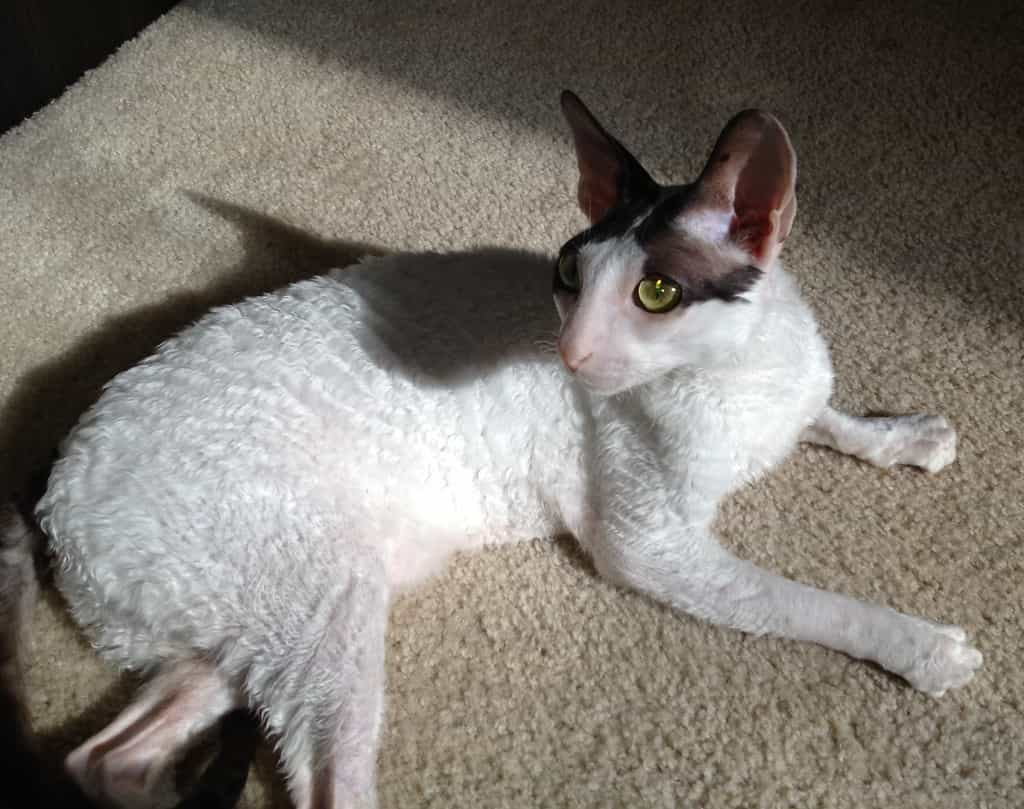

Corish Rexs are not very fond of drinking water. They take most of the fluid from their food. So, wet food is ideal for Active breeds like Cornish Rex. If your cat like dry food, then you can add some snacks such as Tuna fish or Exclusive apt to enhance and increase the palatability and fluid intake that your cat needs.
Cats are very much prone to obesity. So, maintain a schedule of feeding. Don’t share your plate with them. Commercial authentic food is the best for your feline.
Some food recommendations for your Cornish Rex
Exclusive Kattunage- a balanced dry food for kittens and mother cats. Enriched with 34% Protein and 21% Fat. (pics will be added.)
Exclusive Lyster care: Complete for Adult Cats. Enriched with 32.0% Protein and 21.0% Fat. (pics will be added.)
Living requirements of Cornish Rex
Cornish Res breed Needs a warm home and cozy places to lead a comfortable life. They can’t tolerate the cold so if you live in a cold place,, keep all the doors and windows closed during Winter. Keep your cat indoors all the year- in Winter, to save from the cold and the rest of the year, to save from the Sunlight.
Besides this, your Corish is an active and playful breed. So, they need a proper amount of physical activity. Your cat also needs your love and company every day. So, spare some time for your adorable cat.
Provide them with- A warm bed, a cute cat sweater if your cat goes out during the Winter, long cat trees to climb ( So the cat tree must be situated beside a window so that your cat can see out views.), some cat shelves mounted to the walls, a window hammock that your cat can lounge, and fun cat toys.
Some facts about Cornish REX:
- The curly hair trait is also visible in their whiskers and eyelashes, not in their fur.
- The oil on their skin smells like the smell of cheese.
- The Marcel hairstyle of the flappers in the 1920s was very famous. Cornish Rex’s curly fur resembles the hairstyle. So, the breed is also called Marcel cats.
- `Rex` is a Latin word that means the King.
- The breed is a coincidence.
- The Cornish Rex walks peculiarly because of their arched backside.
Cons of Cornish Rex cat:
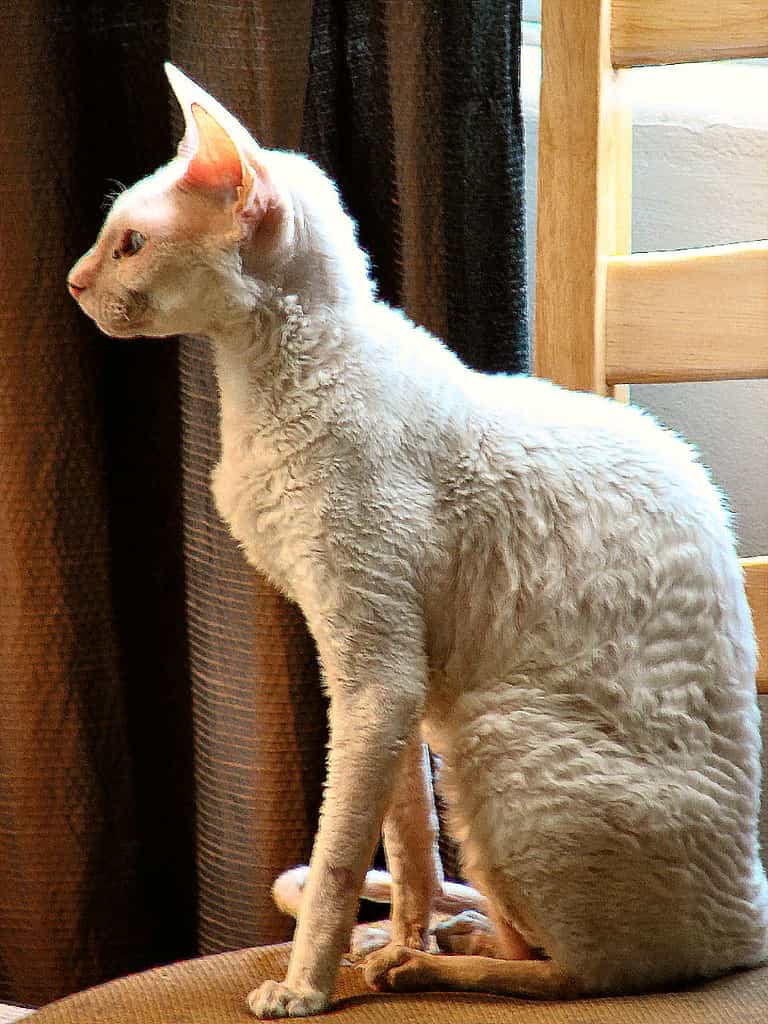

- Very much needy and seeking attention.
- Prone to genetic and coat disorder.
- They have a large appetite. Can be obese and diabetic in the sunset years of their lives.
- If they get outdoors, they can become like Greyhounds and may be difficult to handle.
Overview of Cornish Rex breed
Cornish cats are known for their friendliness towards children and animals if they’re well-behaved. The breed can spend time one by one with all family members, and it is their different characteristics.
An athletic feline with an affectionate personality, slender frame, and elegant appearance. Like the cats, Cornish Rex needs daily company, love, and affection from their owners. They also need mental stimulation, gaming, training, and puzzles with their favorite toys.
So, the most important thing is Cornish Rex depends on cats. So, if you have decided to add it to your family members, you should have the proper time and energy to give the cat. The amusing, elegant, and cuddly buddy is a great attention seeker.
Research any pet before adopting. If you’re determined to adopt, you can search associations’ websites. They publish the reputable breeder’s list.
For Corish Rex, you can search- petfinder.com, adopt-a-pet.com, or go to the local Cornish Rex cat clubs. Also, cat shows are an ideal way to get various cat breeds. You also can find them in shelters and rescue groups.
Physical Characteristics of the Cornish Rex Cat
The Cornish Rex cat is distinguished by its unique physical characteristics, most notably its curly coat. This breed’s coat is not only soft and wavy but also extremely fine, which contributes to its hypoallergenic qualities. Unlike other cats, the Cornish Rex has only the undercoat, or down hair, which is responsible for its signature curls. They are slender and muscular, with a refined build that gives them an elegant appearance. Their heads are small and egg-shaped, topped with large, upright ears that give them an alert, curious look.
Their eyes are wide and expressive, often illuminating their playful and social feline personalities. The Cornish Rex’s body is long and lithe, with a fine bone structure and a distinctive arch to its back. Despite their delicate appearance, they are strong and agile, capable of impressive acrobatics. These physical traits not only contribute to their beauty but also require specific care and attention, particularly when it comes to grooming and diet, to maintain their overall health and well-being.
Cornish Rex Cat Grooming Guide
Grooming a Cornish Rex cat is an essential aspect of their care, given their unique coat and skin needs. Despite having a shorter coat, Cornish Rex cats still require regular grooming to maintain the health and appearance of their curls. Their coat is prone to oil buildup, so it’s important to bathe them regularly with a gentle cat shampoo to keep their skin healthy and coat shiny. When it comes to Cornish Rex cat grooming, use a soft-bristled brush or a fine-toothed comb to gently detangle their curls without damaging the delicate fur.
Regular grooming sessions not only keep their coat in top condition but also provide an opportunity to bond with your cat and check for any skin issues or health concerns. Be mindful of their ears as well, as they can accumulate dirt and require regular cleaning. Grooming your Cornish Rex is not just about maintaining their striking appearance; it’s also a crucial part of caring for their overall health and well-being.
Cornish Rex Cat Training and Exercise
Training and providing adequate exercise for a Cornish Rex cat are crucial aspects of their care, especially considering their high energy levels and intelligent nature. These cats are known for their playful and active behavior, requiring regular mental and physical stimulation to stay happy and healthy. Training Cornish Rex kittens can be both fun and rewarding, as they are typically quick learners who enjoy interactive play. Use toys that encourage chasing and jumping to tap into their natural hunting instincts.
When it comes to exercise, provide plenty of opportunities for your Cornish Rex to climb and explore, such as cat trees or perches. Incorporate puzzle toys and games into their routine to keep their minds active and engaged. Remember, a well-exercised Cornish Rex is likely to be more relaxed and content, reducing the potential for behavioral issues. By understanding and catering to their need for activity, you can ensure your Cornish Rex cat leads a fulfilled and joyful life.
Cornish Rex Cat Adoption Guide
Adopting a Cornish Rex cat can be a wonderful experience, but it requires careful consideration and preparation. When looking to adopt, it’s essential to research and connect with reputable Cornish Rex cat breeders or adoption centers that prioritize the cats’ health and well-being. Understanding the unique personality traits and care requirements of the Cornish Rex is crucial before making the commitment.
When meeting potential cats for adoption, observe their behavior and interaction to ensure a good fit with your family. Prepare your home for your new companion, considering their need for a stimulating environment with plenty of play opportunities. Adopting a Cornish Rex cat is not just about providing a home; it’s about committing to a lifelong companionship, offering love, care, and attention. Embrace the journey of getting to know your Cornish Rex, and enjoy the unique qualities they bring to your life.
Cornish Rex Cat Socialization Guide
Socializing a Cornish Rex cat is key to their development and overall well-being. These cats are known for their sociable and outgoing nature, often enjoying the company of people and other pets. Start socializing Cornish Rex kittens at an early age by exposing them to different people, pets, and environments in a safe and controlled manner. Positive social experiences can help them develop into well-adjusted and confident adult cats.
Incorporate playtime and interaction into their daily routine to nurture their social skills. Remember, every cat is unique, and some may require more time and patience to feel comfortable in social situations. Respect their pace and provide them with a safe and loving environment to grow and thrive. Effective socialization contributes to the well-rounded personality of a Cornish Rex, making them a delightful and affectionate companion.
Conclusion
In summary, the Cornish Rex cat is an extraordinary breed with its distinctive physical traits, vibrant personality, and affectionate nature. Understanding and catering to their unique needs, from specific grooming requirements to their active and sociable disposition, is essential for their well-being. Whether you’re a long-time admirer or considering bringing a Cornish Rex into your life, this guide provides the foundation for a rewarding and loving relationship with these remarkable cats. By embracing the care and companionship of a Cornish Rex, you embark on an enriching journey filled with joy, playfulness, and affection.

